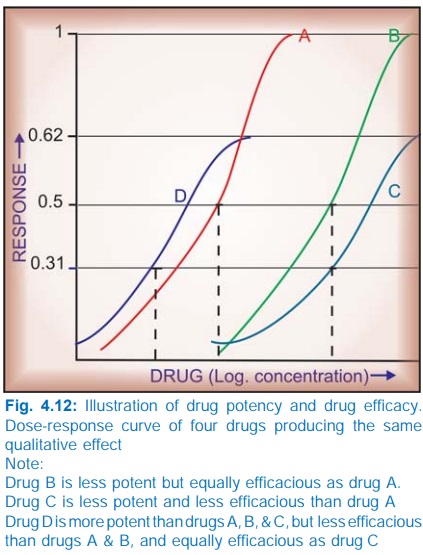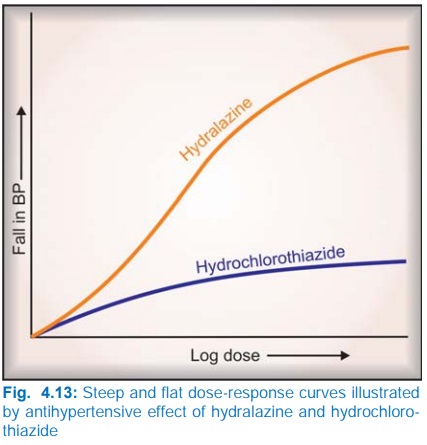Drug Potency and Efficacy
| Home | | Pharmacology |Chapter: Essential pharmacology : Pharmacodynamics Mechanism Of Drug Action; Receptor Pharmacology
The position of DRC on the dose axis is the index of drug potency which refers to the amount of drug needed to produce a certain response. A DRC positioned rightward indicates lower potency.
DRUG POTENCY AND EFFICACY
The position of DRC on the dose axis is the index of drug potency which refers to the amount of drug needed to produce a certain response. A DRC positioned rightward indicates lower potency (Fig. 4.12). Relative potency is often more meaningful than absolute potency, and is generally defined by comparing the dose (concentration) of the two agonists at which they elicit half maximal response (EC50). Thus, if 10 mg of morphine = 100 mg of pethidine as analgesic, morphine is 10 times more potent than pethidine. However, a higher potency, in itself, does not confer clinical superiority unless the potency for therapeutic effect is selectively increased over potency for adverse effect.

The upper limit of DRC is the index of drug efficacy and refers to the maximal response that can be elicited by the drug, e.g. morphine produces a degree of analgesia not obtainable with any dose of aspirin—morphine is more efficacious than aspirin. Efficacy is a more decisive factor in the choice of a drug.
Often the terms ‘drug potency’ and ‘drug efficacy’ are used interchangeably, but these are not synonymous and refer to different characteristics of the drug. The two can vary independently:
§ Aspirin is less potent as well as less efficacious analgesic than morphine.
§ Pethidine is less potent but equally efficacious analgesic as morphine.
§ Furosemide is less potent but more efficacious diuretic than metolazone.
§ Diazepam is more potent but less efficacious CNS depressant than pentobarbitone.
Depending on the type of drug, both higher efficacy (as in the case of furosemide confering utility in renal failure) or lower efficacy (as in the case of diazepam confering safety in overdose) could be clinically advantageous.
The slope of the DRC is also important. A steep slope indicates that a moderate increase in dose will markedly increase the response (dose needs individualization), while a flat one implies that little increase in response will occur over a wide dose range (standard doses can be given to most patients). Hydralazine has a steep, while hydrochlorothiazide has a flat DRC of antihypertensive effect (Fig. 4.13).

Related Topics
